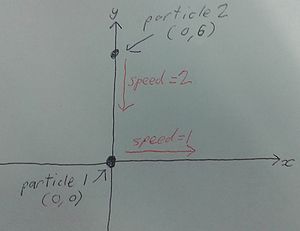Science:Math Exam Resources/Courses/MATH100/December 2014/Question 07 (a)
{{#incat:MER QGQ flag|{{#incat:MER QGH flag|{{#incat:MER QGS flag|}}}}}}
• Q1 (a) • Q1 (b) • Q1 (c) • Q1 (d) • Q1 (e) • Q1 (f) • Q1 (g) • Q1 (h) • Q1 (i) • Q1 (j) • Q2 (a) • Q2 (b) • Q2 (c) • Q2 (d) • Q2 (e) • Q3 (a) • Q3 (b) • Q3 (c) • Q3 (d) • Q3 (e) • Q3 (f) • Q4 (a) • Q4 (b) • Q4 (c) • Q5 (a) • Q5 (b) • Q5 (c) • Q6 (a) • Q6 (b) • Q7 (a) • Q7 (b) • Q8 (a) • Q8 (b) • Q8 (c) • Q8 (d) • Q8 (e) • Q8 (f) • Q9 (a) • Q9 (b) • Q10 • Q11 (a) • Q11 (b) •
Question 07 (a) |
|---|
|
Particle moves on the -axis starting at the point and travels towards origin with constant speed of units per second. Particle moves on the -axis starting at the origin and travels in the positive -direction with constant speed of unit per second. Find a formula for the distance between the particles as a function of time. |
|
Make sure you understand the problem fully: What is the question asking you to do? Are there specific conditions or constraints that you should take note of? How will you know if your answer is correct from your work only? Can you rephrase the question in your own words in a way that makes sense to you? |
|
If you are stuck, check the hint below. Consider it for a while. Does it give you a new idea on how to approach the problem? If so, try it! |
Hint |
|---|
|
First write equations for the coordinates of each of the particles as a function of time. |
|
Checking a solution serves two purposes: helping you if, after having used the hint, you still are stuck on the problem; or if you have solved the problem and would like to check your work.
|
Solution |
|---|
|
Drawn is the starting position and velocity of the particles.
|
{{#incat:MER CT flag||
}}












